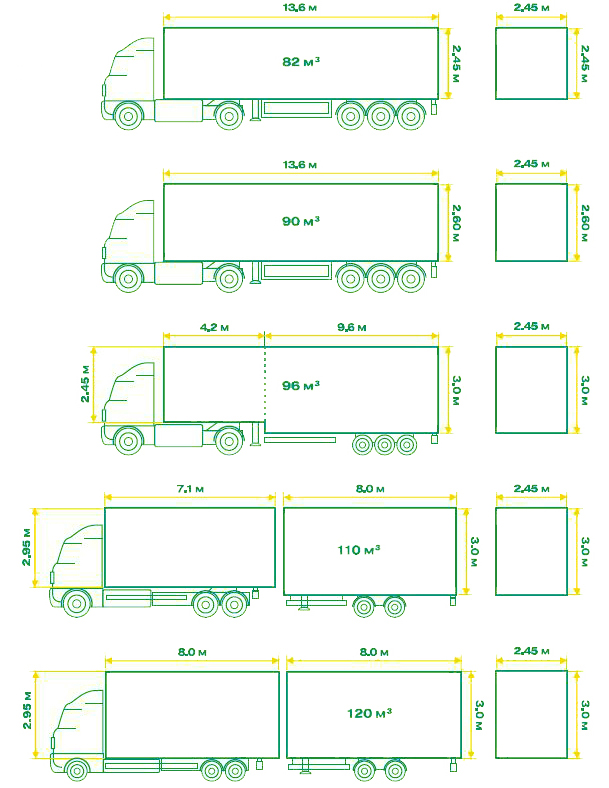Information
CARS TYPE SIZES

• tent, semitrailer
Designed for the transport of most types of cargo.
Loading can be done from the top, side, rear.
Capacity: 20-25 tons
Capacity: 22-33 pallets
Useful volume: from 60-96 m3
• refrigerator, semitrailer
Semi-trailer with a refrigeration unit.
Designed for the transport of perishable goods.
The cargo compartment keeps the temperature from +25 ° C to -25 ° C
Operation of the machines are more expensive than normal by 5-25%.
Capacity: 12-22 tons
Net capacity: 60-92 m3
Capacity: 24-33 euro pallets
"Eurostandard": 20 tons, 82 m3, 32 pallets
• automatic coupler
The car plus trailer.
Advantage: quick loading / unloading and a large storage capacity.
Disadvantage: Not suitable for carrying long items.
Capacity: 16-25 tons
Net capacity: 60-120 m3
Capacity: 22-33 pallets
• «Yumba»
Semitrailer with increased capacity.
Achieved through the "L"-shaped floor and the reduced diameter of the wheels of the semitrailer.
Capacity: up to 20 tons
Net capacity: 96-110 m3
Capacity: 33 pallets
• container transporter
Suitable for containers of various kinds.
Capacity: 20-30 tons.
• road tank car
It is intended for the carriage of liquids.
Capacity: 12-22 tons
Volume: 8-40 m3
CONTAINERS TYPES AND SIZES
|
|||||||||||||||||||||
|
|||||||||||||||||||||
|
|||||||||||||||||||||
|
|||||||||||||||||||||
|
|||||||||||||||||||||
|
|||||||||||||||||||||
|
|||||||||||||||||||||
|
|||||||||||||||||||||
|
|||||||||||||||||||||
CLASSES OF DANGEROUS GOODS
|
1 class |
 |
1 class of dangerous goods – explosive materials with properties that may explode and cause fire with explosive action, and devices containing explosives and explosive materials, intended to produce a pyrotechnic effect. |
|
2 class |
 |
2 class of dangerous goods – Compressed gases, liquefied, cooled and dissolved under pressure, meet at least one of the following conditions. |
|
3 class |
 |
3 class of dangerous goods – flammable liquids, mixtures of liquids and liquids containing solids in solution or suspension, which emit flammable vapors having a flash point in closed crucible 6 ° C and below. |
|
4 class |
 |
4 class of dangerous goods – flammable substances and materials (except those classified as explosives), which during transportation is easily lit from an external source of ignition through friction, absorption of moisture, spontaneous chemical reactions, as well as heating. |
|
5 class |
 |
5 class of dangerous goods – Oxidizing substances and organic peroxides, which can easily release oxygen to support combustion and may, in appropriate circumstances in a mixture with other substances, cause ignition and explosion. |
|
6 class |
 |
6 class of dangerous goods – poisonous and infectious substances which can cause death, disease or poisoning if swallowed or in contact with skin and mucous membranes. |
|
7 class |
 |
7 class of dangerous goods – radioactive material with a specific activity of 70 kBq / kg (2 nCi / g). |
|
8 class |
 |
8 class of dangerous goods – caustic and corrosive substances that cause damage to the skin, mucous membranes of the eyes and respiratory tract, metal corrosion and damage to vehicles, buildings or goods, and can cause fire in contact with organic materials or certain chemicals. |
|
9 class |
 |
9 class of dangerous goods – substances with relatively low risks in the transportation referred to any of the previous classes, but which require the application to them of certain rules for the transport and storage. |



































